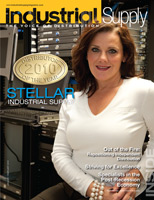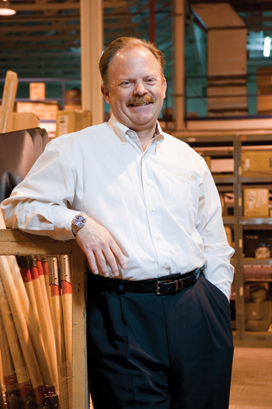A Game of Inches
Stellar Industrial Supply utilizes pricing analytics model to make incremental margin improvements
Winner of Industrial Supply magazine's 2010 Distributor of the Year Award
by Rich Vurva

In the old days, distributors maximized profits by increasing sales. In the current economic climate, margin gains are more difficult to achieve. Stellar Industrial Supply of Tacoma, Wash., discovered that it is possible to make incremental margin improvement even when sales are flat or down. The company was an early adopter of a relatively new strategic pricing partnership between its distribution software provider, Activant Solutions, and Strategic Pricing Associates Inc. (SPA), a Cleveland, Ohio-based pricing analytics company.
“Activant formed an exclusive relationship with SPA to simplify the task of setting prices at optimal levels,” said Kevin Roach, executive vice president and general manager of the Activant Wholesale Distribution Group. “The Strategic Pricing module, which is fully integrated with the Activant Distribution Suite, analyzes a distributor’s database for customer and order information and then classifies customers by type and size. The module then exports the invoice data to SPA for statistical analysis, which recommends how to optimally price every customer/product combination.”
 Stellar has been a long-time user of Activant’s Prophet 21 software and occasionally offers suggestions to enhance the enterprise system solution. Over the past few years, Stellar president, John Wiborg, and vice president of technology, Rene Savage, mentioned their need for a pricing program to help manage margins. When Activant announced its partnership with SPA and asked Stellar to be a beta tester of its new software module, the distributor of industrial and safety supplies readily agreed.
Stellar has been a long-time user of Activant’s Prophet 21 software and occasionally offers suggestions to enhance the enterprise system solution. Over the past few years, Stellar president, John Wiborg, and vice president of technology, Rene Savage, mentioned their need for a pricing program to help manage margins. When Activant announced its partnership with SPA and asked Stellar to be a beta tester of its new software module, the distributor of industrial and safety supplies readily agreed.
“We knew that if we could play a role in helping develop the software – from a selfish standpoint – it would fit our needs, but it could also help the industrial supply industry across the country,” says Savage.
The process began in January 2009 when Stellar submitted 12 months of invoice data to SPA showing what customers paid for specific products and services, how much they bought, and other order characteristics. SPA then applied its proprietary analytical models to the data to recommend what Stellar’s pricing architecture should look like, varying price levels by customer type and size and the predicted sensitivity level of individual products.
“We profile the relative sensitivity of customers and products to recommend pricing structures that focus discounting where it pays off in the market, and extract price premiums where there is less sensitivity,” says SPA president David Bauders.
He says a typical distributor may have 10,000 items and 5,000 customers. That translates into 50 million potential pricing combinations.
“It’s a very complex problem. Our company specializes in the analytics to see through that complexity where they can extract premium prices on the less sensitive products and the less sensitive customers,” Bauders says.
 SPA recommends price levels by product/service category and customer segment, as well as customer- and product-specific price levels. As a simple example, some items might be classified as a core A or B item, which are more price-sensitive, while products that are less price-sensitive might be classified as non-core C and D items. Even within a single vendor or product family, items may have very different levels of price sensitivity. SPA helps companies laser in on how to exploit these differences.
SPA recommends price levels by product/service category and customer segment, as well as customer- and product-specific price levels. As a simple example, some items might be classified as a core A or B item, which are more price-sensitive, while products that are less price-sensitive might be classified as non-core C and D items. Even within a single vendor or product family, items may have very different levels of price sensitivity. SPA helps companies laser in on how to exploit these differences.
“The thought is your core items will be more price-sensitive in the marketplace than your D items, so the pricing structure can be modified to make more money on those D items,” says Savage. In the example, a Rayovac battery might be classified as a Core A item, but replacement bulbs for the flashlight could be categorized as a D item, and earn a higher margin.
SPA also develops guidelines to help distributors manage and control exceptions to the architecture, and to identify “pricing leakage points” in the business. SPA offers extensive training to improve distributors’ pricing processes and educate their sales forces in effective pricing practices.
Within a few weeks after receiving Stellar’s sales history, SPA returned the recommended pricing structures to Stellar for review. In some cases, the pricing structures were tweaked to reflect Stellar’s preferences. For example, suppose cherry flavored Sqwincher was more popular with customers than orange flavored, placing it in a different pricing category based on volume sales. Stellar can adjust the data to make sure the two items had the same price.
Education process
The final step before going live with the strategic pricing module was to hold several education sessions with the sales and customer service staffs. The training helped alleviate fear among salespeople that they would be immediately forced to raise their prices and lose sales as a result. It also uncovered situations where salespeople out priced themselves or needlessly undercut margins.
“We’ve had training almost every month on the system and on margin management,” says Savage. Training focused on why pricing decisions are better handled at the corporate level than by salespeople. The strategic pricing approach takes the guesswork out of pricing, enabling salespeople to focus on selling value instead of price.
“We don’t allow any price overrides by salespeople. Exceptions go through a pricing committee for review,” says Savage. The pricing committee – which consists of Wiborg, Savage and Dan Kure, named to a newly created position of vice president of strategic pricing – meets regularly to monitor progress.
To reinforce selling on value, Stellar developed a documented cost savings Web site.
“We consider ourselves to be a service provider, not a sales organization,” explains Wiborg. “So our staff already knew the importance of providing our customers with fair, consistent service, which is important in this economy.”
The training also emphasized the importance of having a pricing structure that was fair to customers. In the past, some customers might be quoted different prices on the same item, depending upon the CSR or salesperson who took their call. Wiborg believes that is a customer service failure.
“With strategic pricing, no matter who they talk to, they’ll be quoted the same price,” says Wiborg. “By implementing strategic pricing, we are able to offer our customers items at a fair market price at a level of profitability that allows us to reinvest in the business, which ultimately helps our customers.”
 Immediate Improvement
Immediate Improvement
SPA estimates that implementing strategic pricing methods can increase a distributor’s gross margins anywhere from two to four percentage points in the first year alone. The program is typically worth $200,000 per year for every $10 million in affected revenue. SPA has successfully implemented this program with more than 250 distribution businesses across a wide variety of segments. It offers a money-back guarantee to clients and only bills them after they are making money in the program.
Stellar saw improvements almost immediately. “We rolled out strategic pricing on June 1,” says Wiborg. “We didn’t lock it down immediately since some back orders still needed to flow through the system, but by the middle of the month, we could already see some improvement.”
In one recent month, Kure says the amount of total sales that flowed through the strategic pricing system ranged from 7% at one branch to 31% at another. As the name suggests, strategic pricing must be applied strategically and won’t work across all customer segments. Business that falls under contract, such as integrated supply and other on-site inventory management agreements, isn’t directly impacted by the SPA module.
“When it comes time to renew those contracts, we can either try to increase some of the pricing or take items off the contract and put them into the strategic pricing system. It’s a game of inches,” says Kure.
Kure says pricing decisions must be implemented gradually and with great care to avoid losing customers. He says you don’t want to lose millions of dollars in sales while trying to gain 2% to 4% more in margin. SPA has developed multiple reports that help Kure and Savage analyze the data in search of additional ways to gain margin improvement.
“It is important to realize that just because you centralize pricing, you don’t reduce flexibility,” stresses Wiborg. “It does reduce complexity so we learn faster what we need to do to be fair to our customers. That speed is important, especially in this economic climate.”
Bauders adds that even the best pricing structures require exceptions. The key is limiting pricing overrides, establishing controls and setting boundaries. Having the right degree of control vs. flexibility is a balancing act. “Our tools enable a company to manage that balancing act more intelligently and more strategically,” he says.
Streamlined process
Stellar has realized additional process improvements since implementing the strategic pricing system. The purchasing department handles fewer price overrides in managing pricing agreements with suppliers. Accounting spends less time reconciling purchase orders and invoices, and salespeople are more confident in the pricing data.
“By going through this process, and working with Activant and SPA, it helped us see business processes and other areas of our business that needed to be cleaned up and reviewed,” says Wiborg. “We’re improving efficiencies and better managing supplier pricing, which helps with our marketing and purchasing efforts. We’re closing loopholes in our processes that we didn’t know existed.”
This article originally appeared in the Jan./Feb. 2010 edition of Industrial Supply magazine. Copyright 2010, Direct Business Media, LLC.













